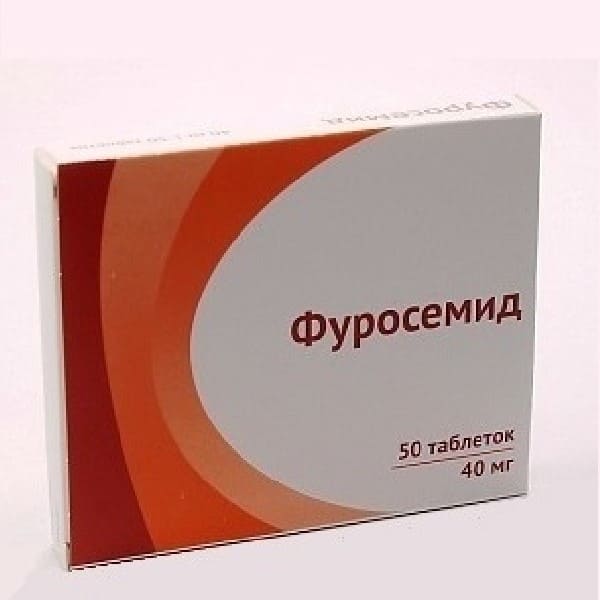You have no items in your shopping cart.

Sku:
Dosage form
pills
Composition
Furosemide 40mg; Auxiliary substances: milk sugar, potato starch, magnesium stearate
Pharmacological action
Loop diuretic; it was coming fast, strong and short diuresis. Narushayut the reabsorption of sodium and chlorine ions in the proximal and distal sections of the convoluted tubules and in the thick segment of the ascending part of loop of Henle. Furosemide has a marked diuretic, natriuretic and chloruretic action. In addition, increases the excretion of potassium, calcium, magnesium.
Pharmacokinetics
High absorption, Cmax observed in plasma when administered after 1 h.
Bioavailability of 60-70%. Relative Vd - 0.2 l/kg. Linking blood plasma proteins - 98%. Penetrates through the placental barrier, excreted in breast milk. Metabolized in the liver to form 4-chloro-5-sulfamoilantranilovoy acid. Secreted into the lumen of the renal tubules through the existing in the proximal nephron transport system of the anions. It is excreted mainly (88%) by the kidneys in unchanged form and as metabolites; the remainder is intestine. T1/2 is 1-1.5 hours
Features of the pharmacokinetics of individual groups of patients
In renal failure, the elimination furosemide is slowed down, and T1/2 increased; in severe renal failure final T1/2 may increase up to 24 h.
In nephrotic syndrome, the decrease in plasma concentrations of proteins leads to higher concentrations of unbound furosemide (its free fraction) in this connection, increases the risk of ototoxic action. On the other hand,
the diuretic effect of furosemide in these patients may be reduced due to the binding of furosemide to albumin, which is in the tubules and reduction in tubular secretion of furosemide.
In hemodialysis, peritoneal dialysis and continuous ambulatory peritoneal dialysis furosemide excreted slightly.
When liver failure T1/2 of the furosemide increases by 30-90%, mainly due to the increase of the relative volume distribution. The pharmacokinetic parameters in this category of patients can vary significantly.
In heart failure, severe hypertension and in elderly patients the elimination of furosemide is slowed down due to the loss of kidney function.
Side effects
From the side of cardiovascular system: expressed lower AD, collapse, tachycardia, arrhythmia, tendency to thrombosis, reduction in blood volume.
From the Central nervous system: dizziness, headache, muscle weakness, spasms of the calf muscles (tetany), paresthesia, apathy, weakness, weakness, lethargy, drowsiness, confusion.
From the sensory organs: impaired vision and hearing, tinnitus.
From the digestive system: anorexia, dry mucous membranes of the mouth, thirst, nausea, vomiting, diarrhea, constipation, cholestatic jaundice, pancreatitis (exacerbation), hepatic encephalopathy.
From the urogenital system: oliguria, acute urinary retention (in patients with benign prostatic hyperplasia), interstitial nephritis, hematuria, reduced potency.
From the endocrine system: reduced tolerance to glukoze, latentsiperioodiga manifestation of diabetes.
Allergic reactions: purpura, urticaria, exfoliative dermatitis, erythema multiforme exudative, vasculitis, necrotizing angitis, itching, chills, fever, photosensitivity, anaphylaxis, Stevens-Johnson syndrome, bullous pemphigoid, toxic epidermal necrolysis.
Organs of hematopoiesis: leukopenia, thrombocytopenia, agranulocytosis, aplastic anemia, eosinophilia.
From the water-electrolyte metabolism: hypovolemia, dehydratase (risk of thrombosis and thromboembolism), hypokalemia
Special conditions
Before therapy, the drug Furosemide Sopharma to exclude the presence of significant violations of the outflow of urine, patients with partial violation of outflow of urine, need careful observation. On the background of a course of treatment should periodically monitor the AD, the content of electrolytes of blood plasma ( including the ions sodium, calcium, potassium, magnesium), acid-base status, residual nitrogen, creatinine, uric acid, liver function, and conduct, if necessary, appropriate corrective treatment.
Furosemide slows down the excretion of uric acid, which can cause exacerbation of gout.
Patients with hypersensitivity to sulfonamides and sulfonylureas may have cross-sensitivity to furosemide.
Patients receiving high doses of furosemide, in order to avoid the development of hyponatremia and metabolic alkalosis is impractical to limit the intake of salt. For the prevention of hypokalemia to the simultaneous administration of potassium supplements and potassium-sparing diuretics, and also to adhere to a diet rich in potassium. Selection of dosing regimen in patients with ascites in cirrhosis of the liver should be carried out in stationary conditions (disorders of fluid and electrolyte balance may cause hepatic coma). These patients showed regular control over the content of plasma electrolytes.
Is new or increasing azotemia and oliguria in patients with severe progressive renal diseases is recommended to suspend the treatment.
In patients with diabetes mellitus or reduced tolerance to glucose requires periodic monitoring of glucose concentrations in blood and urine.
Patients unconscious with benign prostatic hyperplasia, narrowing of the ureters or hydronephrosis is necessary to monitor urine output in connection with the possibility of acute urinary retention.
The drug contains lactose monohydrate, therefore patients with rare hereditary problems of galactose intolerance, the lapp lactase deficiency or malabsorption of glucose-galactose should not take this medicinal product.
In the preparation includes starch wheat in an amount that is safe for use in patients with celiac disease (coeliac).
Patients with wheat Allergy (different from coeliac disease) should not use this drug.
Effects on ability to drive vehicles and management mechanisms
During treatment, the drug Furosemide Sopharma should avoid activities potentially hazardous activities, require increased attention and psychomotor speed reactions (driving vehicles and operating mechanisms).
Testimony
Edematous syndrome in congestive heart failure IIB-III stages, liver cirrhosis, kidney disease (including nephrotic syndrome); acute left ventricular failure (pulmonary edema), swelling in case of burns, hypertension.
Contraindications
Hypersensitivity to furosemide, acute kidney failure with anuria (the value of glomerular filtration less than 3-5 ml/min), severe liver failure, hepatic coma, acute glomerulonephritis, stenosis of the urethra, obstruction of urinary tract stone, hyperglycemic coma, hyperuricemia, gout, decompensated mitral or aortic stenosis, increased Central venous pressure (more than 10 mm Hg.St.), idiopathic hypertrophic subaortic stenosis, arterial hypotension, acute myocardial infarction, systemic lupus erythematosus, pancreatitis, violation of water-electrolyte metabolism (hypovolemia, hyponatremia, hypokalemia, gipohloremia, hypocalcemia, hypomagnesemia), digitalisna intoxication.
Drug interactions
While the use of phenobarbital and phenytoin decreases the effect of furosemide.